221 search results - page 30 / 45 » Word Sense Disambiguation Using Pairwise Alignment |
TSD
2001
Springer
14 years 27 days ago
2001
Springer
This paper presents a new method to enrich semantically WordNet with categories from general domain classification systems. The method is performed in two consecutive steps. First,...
ESWS
2010
Springer
14 years 1 months ago
2010
Springer
In this paper we build on our methodology for combining and selecting alignment techniques for vocabularies, with two alignment case studies of large vocabularies in two languages....
LREC
2010
13 years 10 months ago
2010
Conventional methods for disambiguation problems have been using statistical methods with co-occurrence of words in their contexts. It seems that human-beings assign appropriate w...
COLING
2008
13 years 10 months ago
2008
Supervised approaches to Word Sense Disambiguation (WSD) have been shown to outperform other approaches but are hampered by reliance on labeled training examples (the data acquisi...
CSL
2004
Springer
13 years 8 months ago
2004
Springer
This paper explores factors correlating with lack of inter-annotator agreement on a word sense disambiguation (WSD) task taken from SENSEVAL-2. Twenty-seven subjects were given a ...

